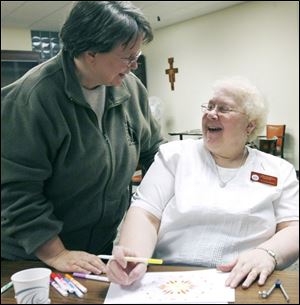
Artists can find healing in ancient symbols, nun says
10/11/2008
Sister Sharon Havelak, left, and Sister La Donna Pinkelman talk during a mandala workshop Sister Sharon conducts.
Mandalas, ancient symbols of prayer and meditation used by many religious groups, can be small or large, simple or ornate, made with colored crayons or finely crushed stone.
There is almost complete artistic freedom in creating mandalas, the only requirement being that they are circular in shape, said Sister Sharon Havelak, a Sylvania Franciscan nun who leads mandala workshops at the Sylvania campus, 6832 Convent Blvd., including one on Thursday.
'I've been an art instructor for a very long time, and I had noticed in myself that simply sitting down and producing artwork is a very healing activity,' Sister Sharon said.
When she assigned classes to make mandalas, the students told her the symbols had a noticeable impact on their moods and their spirits.
'They would find changes within themselves. Stress would be relieved. They were not as anxious about problems they were facing, or solutions would come to them as they were working on the mandalas. This reinforced my own experience,' Sister Sharon said.
The word 'mandala' is Sanskrit for 'circle,' and the symbols have been around for thousands of years. Mandalas originated among the Hindus but are widely used as meditation and prayer tools by Buddhists.
In recent years, mandalas are becoming increasingly popular in Judaism, Christianity, and Islam.
Buddhist monks are known for creating intricate mandalas out of colored sand. According to tantric practice, Buddhists consider mandalas to be 'sacred abodes of meditation deities, and as such are expression of enlightened qualities of mind such as compassion and wisdom,' author Don Farber wrote in Tibetan Buddhist Life.
A wealth of meaning can be found in mandalas, including symbols of celestial circles, the cosmos, and the structure of life itself as seen by humanity looking at the universe.
In September, a group of seven Tibetan Buddhist monks from the Gaden Shartse Monastery in India visited Toledo and created a sand mandala that honored the Medicine Buddha at St. Ann Mercy Hospital's Cancer Center.
Sister Sharon said mandalas can be sculpted, painted, drawn, or made of sand, but she usually has students create them with color pencils or crayons.
'There is a lot of crossover [among religions] in terms of mandalas,' she said. 'Some look at the Rose Windows of Rosary Cathedral as a form of mandala, telling the story of Christianity in a circular format.'
Sister Sharon Havelak will lead a mandala workshop at 1 p.m. Thursday in the Regina Conference Room, behind the Queen of Peace Chapel, on the campus of the Sylvania Franciscan nuns, 6832 Convent Blvd., Sylvania.
The nuns' fall spirituality workshop series also includes a brown bag session titled 'Who Me? Holy?' at 11:30 Monday, led by Sister Helen Frances Spears and Sister Patricia Shea-Remley, and a Labyrinth Experience at 6:30 p.m. Oct. 22 and 9:30 a.m. Oct. 28, led by Linda Schlachter.
More information is available by calling 419-824-3606 or online at
sistersosf.org.
David Yonke